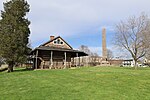Fort Randolph (West Virginia)

Fort Randolph was an American Revolutionary War fort which stood at the confluence of the Ohio and Kanawha Rivers, on the site of present-day Point Pleasant, West Virginia, United States. Built in 1776 on the site of an earlier fort from Dunmore's War, Fort Randolph is best remembered as the place where the famous Shawnee Chief Cornstalk was murdered in 1777. The fort withstood attack by American Indians in 1778 but was abandoned the next year. It was rebuilt in the 1780s after the renewal of hostilities between the United States and American Indians, but saw little action and was eventually abandoned once again. Two centuries later, a replica of the fort has been built about a mile away.
Excerpt from the Wikipedia article Fort Randolph (West Virginia) (License: CC BY-SA 3.0, Authors, Images).Fort Randolph (West Virginia)
Lighthouse Lane,
Geographical coordinates (GPS) Address Nearby Places Show on map
Geographical coordinates (GPS)
| Latitude | Longitude |
|---|---|
| N 38.83765 ° | E -82.12202 ° |
Address
Lighthouse Lane
Lighthouse Lane
25106
West Virginia, United States
Open on Google Maps








